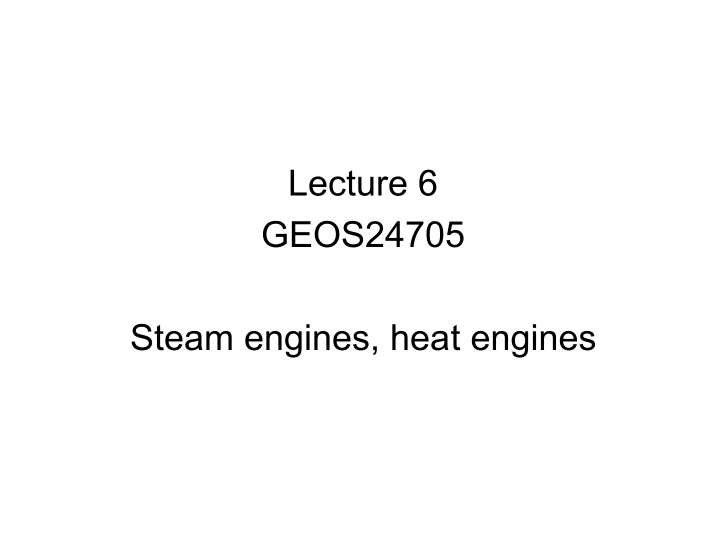



Lecture 6 GEOS24705 Steam engines, heat engines
First ¡true ¡steam ¡engine: ¡ ¡ Thomas ¡Newcomen, ¡1712, ¡blacksmith ¡ ¡ Copy ¡of ¡Papin’s ¡engine ¡of ¡design ¡of ¡1690 ¡ ¡ First ¡ reciproca(ng ¡engine : ¡linear ¡moDon ¡of ¡ piston ¡that ¡transmits ¡force ¡ ¡ Issues: ¡ Very ¡low ¡efficiency: ¡0.5%? ¡ IntermiLent ¡force ¡transmission ¡ Newcomen ’ s ¡design ¡is ¡state ¡of ¡the ¡art ¡for ¡60+ ¡years ¡
All ¡heat ¡engines ¡involve ¡heat ¡flow ¡ No ¡heat ¡engine ¡has ¡perfect ¡efficiency ¡ All ¡heat ¡engines ¡involve ¡waste ¡heat ¡ Cooling ¡towers ¡from ¡Ca<enom ¡nuclear ¡power ¡plant ¡ (heat ¡from ¡reactor ¡drives ¡a ¡steam ¡turbine) ¡
First ¡modern ¡steam ¡engine: ¡ ¡ James ¡WaL, ¡1769 ¡patent ¡ ¡ ¡ ¡ ¡ ¡ ¡(1774 ¡producDon ¡model) ¡ ¡ Similar to Newcomen’s engine, but with steam now condensing in a separate condenser that is kept always cool. In Newcomen’s engine, the metal cylinder would alternately heat and cool when filled with steam or when cooling water is added in condensing step. In Watt’s engine, steam enters alternately at top and bottom of cylinder. As piston begins to move down, steam flushes into condenser where it condenses, providing the suction that is most of the force on the engine. Lower fuel usage than Newcomen’s engine.
First ¡modern ¡steam ¡engine: ¡ James ¡WaL, ¡1769 ¡(patent), ¡1774 ¡(prod.) ¡ Higher ¡efficiency ¡than ¡Newcomen ¡by ¡introducing ¡separate ¡condenser ¡ Reduces ¡wasted ¡heat ¡by ¡not ¡heaDng ¡and ¡cooling ¡enDre ¡cylinder ¡ ¡
Improved ¡Wa< ¡steam ¡engine: ¡ ¡ James ¡WaL, ¡1783 ¡model ¡ Albion ¡Mill, ¡London ¡ ¡ As ¡before: ¡ Separate ¡condenser ¡ ¡ ¡ Improvements: ¡ Force ¡on ¡both ¡up-‑ ¡and ¡downstroke ¡ • ConDnuous ¡force ¡transmission ¡ • RotaDonal ¡moDon ¡ • Engine ¡speed ¡regulator ¡ • Higher ¡efficiency: ¡ca. ¡3% ¡ • Engineers ¡cared ¡about ¡efficiency ¡– ¡ ¡ coal ¡= ¡money ¡ ¡ ¡ video of 1788 engine
First ¡locomoFves ¡– ¡a<empts ¡to ¡convert ¡staFonary ¡steam ¡engines ¡ built ¡by ¡Richard ¡Trevithick, ¡mining ¡engineer ¡ Experimented ¡with ¡“high-‑pressure” ¡steam ¡(50 ¡psi), ¡double-‑acDng ¡cylinders. 1804 ¡Pen-‑y-‑Darren ¡locomoDve, ¡carrying ¡iron ¡in ¡Wales, ¡replacing ¡horse-‑ drawn ¡tramway. ¡Ran ¡~10 ¡miles ¡at ¡~2 ¡mph ¡but ¡destroyed ¡track. ¡ Image: ¡1804 ¡Coalbrookdale ¡ locomoFve, ¡which ¡failed. ¡No ¡ images ¡of ¡Pen-‑y-‑Darren ¡survive ¡ ¡ ¡
First ¡pracFcal ¡locomoFves ¡begin ¡1814 ¡ “ Puffing ¡Billy ” , ¡designed ¡by ¡William ¡Hedley, ¡(mine ¡manager), ¡ ¡ built ¡by ¡the ¡mine’s ¡blacksmith ¡and ¡enginewright ¡ Coal ¡hauler, ¡9 ” ¡x ¡36 ” cylinders ¡ ¡ SDll ¡basically ¡a ¡staDonary ¡steam ¡engine ¡placed ¡on ¡wheels ¡ Image: ¡source ¡unknown ¡
First ¡passenger ¡locomoFve, ¡1829 ¡ George ¡Stephenson’s ¡ “ Rocket ” , ¡built ¡for ¡Liverpool ¡and ¡Manchester ¡Railway ¡ won ¡the ¡Rainhill ¡trials ¡at ¡29 ¡mph ¡(unloaded), ¡14 ¡mph ¡loaded ¡ first ¡example ¡of ¡single ¡pair ¡of ¡drive ¡wheels ¡ Stephenson was a mine engineman and brakeman, then enginewright. Illiterate til age 18. Built first locomotive in 1814. Image: ¡source ¡unknown ¡
Double-‑acFng ¡steam ¡engine ¡ ¡ Piston ¡pushed ¡by ¡steam ¡on ¡both ¡ up-‑ ¡and ¡down-‑stroke. ¡ ¡ No ¡more ¡need ¡for ¡a ¡ ¡condenser. ¡ Steam ¡is ¡simply ¡vented ¡at ¡high ¡ temperature ¡slide ¡valve ¡alternates ¡input ¡& ¡exhaust ¡
Double-‑acFng ¡steam ¡engine ¡ slide valve alternates input & exhaust
Double-‑acFng ¡steam ¡engine ¡ primary use: transportation
Double-‑ac*ng ¡steam ¡engine ¡ ¡ ¡ What ¡are ¡benefits? ¡ ¡ ¡ ¡ ¡ ¡ ¡ ¡ What ¡are ¡drawbacks? ¡ ¡ ¡ ¡ ¡
Double-‑ac*ng ¡steam ¡engine ¡ ¡ ¡ What ¡are ¡benefits? ¡ ¡ Faster ¡cycle ¡– ¡no ¡need ¡to ¡wait ¡for ¡condensaFon. ¡Can ¡get ¡ more ¡power, ¡higher ¡rate ¡of ¡doing ¡mechanical ¡work. ¡ ¡ Also ¡ lighter ¡and ¡smaller ¡– ¡no ¡need ¡to ¡carry ¡a ¡condenser ¡ around. ¡ ¡ What ¡are ¡drawbacks? ¡ ¡ Inefficiency ¡– ¡venFng ¡hot ¡steam ¡means ¡you ¡are ¡wasFng ¡ energy. ¡ ¡ High ¡water ¡usage ¡– ¡since ¡lose ¡steam, ¡have ¡to ¡keep ¡replacing ¡ the ¡water ¡
Double-‑acFng ¡steam ¡engine: ¡ Images ¡top, ¡leS: ¡Sandia ¡SoSware ¡ Image ¡bo<om: ¡Ivan ¡S. ¡Abrams ¡ water-‑intensive, ¡ fuel-‑intensive ¡– ¡ requires ¡many ¡ stops ¡to ¡take ¡on ¡ water ¡and ¡fuel.
History ¡of ¡locomoFves ¡ Central ¡Pacific ¡Railroad ¡locomoDve ¡#173, ¡Type ¡4-‑4-‑0, ¡1864 ¡ Image: ¡Central ¡Pacific ¡Railroad ¡ Photographic ¡History ¡Museum ¡
History ¡of ¡locomoFves ¡ Northern ¡Pacific ¡Railway ¡steam ¡locomoDve ¡#2681, ¡1930 Image: ¡ ¡Buckbee ¡Mears ¡Company, ¡Photograph ¡CollecFon ¡ca. ¡1930, ¡LocaFon ¡ no. ¡HE6.1N ¡p11, ¡NegaFve ¡no. ¡25337. ¡Source: ¡Minnesota ¡Historical ¡Society ¡ ¡
Recommend
More recommend